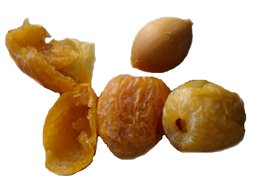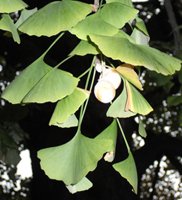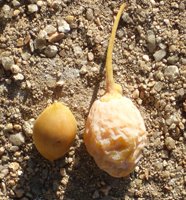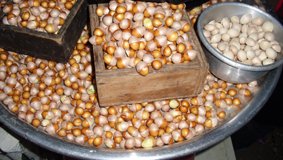Ginkgo nuts Nutrition facts
Ginkgo nuts (银杏坚果), in fact, are nut-like edible gametophytes of Gingko biloba (Maidenhair) tree. Though the kernels are composed of incredible phytonutrients and antioxidants profile, they are also the source of the neurotoxin, ginkgo-toxin. For the same reason, ginkgo seeds should be consumed in limited quantities to enjoy them safely as food.Gingko Biloba is a large, long-living, deciduous tree in the family of Ginkgoaceae, and is the only existing member of the genus, Gingko. Its soft, yet chewy textured kernels are eaten either toasted or in dishes in the far East-Asian cuisine for their nutritional as well as medicinal properties.

|
| Ginkgo nut and fleshy fruit. |
Ginkgo trees are native to East Asia, thought to have originated in the deep forests of China. It is a large tree and grows up to 50 meters in height. It is a very hardy plant and can survive under a wide range of environmental conditions. Ginkgo is a dioecious plant with both male and female trees growing separately. These days, they are being planted as ornamental roadside trees as well as cultivated in nurseries for their medicinal value of leaves.
 |
| Ginkgo biloba foliage and fleshy fruit. |
Female ginkgo tree bears oval to round, fleshy fruits about the size of small jujube (Chinese date). Its outer, nasty smelling pulp (exocarp) is known botanically as sarcotesta. A single hard-shelled seed enclosing an edible embryo (kernel) is situated in the center of the fruit. An edible ginkgo nut is actually a gametophyte surrounded by a thin membranous layer inside this hardshell as in pistachio. Ginkgo kernels measure about 1.5-2 cm in length and 1 cm in diameter and feature a light jade green hue.
Are Ginkgo nuts healthy? What science says?
Ginkgo should be eaten in limited quantities. Consumption of more than ten raw or cooked nuts in a day may cause 4’-O-methylpyridoxine (Ginkgotoxin) poisoning. Ginkgotoxin is a heat-stable compound and cannot be destroyed by cooking. It interferes with pyridoxine (vitamin B-6) metabolism in the human body and may lead to a range of symptoms including stomachache, nausea, vomiting, nervous irritability, convulsions, and sometimes death. The toxicity and symptoms, however, can be reversed by taking pyridoxine supplements. In general, children would tolerate up to five kernels per day, and adults about ten per day. (Medical Disclaimer).
Ginkgo seeds have long been part of traditional food items in the far East-Asian cuisine. The kernels are quite low in calories in comparison to any other tree nuts such as walnuts, almonds, etc. 100 g of fresh, raw ginkgo kernels composed of 182 calories.
Traditionally, the Chinese consumed ginkgo seeds to get relief from breathing problems since they consider them to confer a yang (warmth) effect. The kernels are also believed to ease asthma, bronchitis, and urinary tract ailments.
Unlike ginkgo leaf, which FDA approved as a food supplement, the kernels have yet to attain this status in the United States.
Overall, the ginkgo nuts may be used in small quantities as medicine instead as a staple food source unlike in other edible nuts and seeds.
When eaten in limited and specified amounts, ginkgo nuts would confer some of the health benefits.
Ginkgo nuts compose small amounts of B-complex groups of vitamins such as riboflavin, niacin, thiamin, pantothenic acid, vitamin B-6, and folates.
These nuts are the storehouse of minerals like copper, manganese, potassium, calcium, iron, magnesium, zinc, and selenium. Copper is an essential trace mineral that is required for neurotransmission, metabolism, as well as red blood cell (RBC) synthesis.
| Principle | Nutrient Value | Percent of RDA |
|---|---|---|
| Energy | 182 Kcal | 9% |
| Carbohydrates | 37.6 g | 29% |
| Protein | 4.32 g | 8% |
| Total Fat | 1.68 g | 7% |
| Cholesterol | 0 mg | 0% |
| Vitamins | ||
| Folates | 54 µg | 13% |
| Niacin | 6 mg | 37.5% |
| Pantothenic acid | 0.160 mg | 3% |
| Pyridoxine | 0.328 mg | 25% |
| Riboflavin | 0.160 mg | 12% |
| Thiamin | 0.220 mg | 18% |
| Vitamin A | 558 IU | 18% |
| Vitamin C | 15 mg | 25% |
| Electrolytes | ||
| Sodium | 7 mg | 0.5% |
| Potassium | 510 mg | 11% |
| Minerals | ||
| Calcium | 2 mg | 0.2% |
| Copper | 0.274 mg | 30% |
| Iron | 1.00 mg | 12.5% |
| Magnesium | 27 mg | 7% |
| Manganese | 0.113 mg | 5% |
| Phosphorus | 124 mg | 18% |
| Zinc | 0.34 mg | 3% |
Selection and storage
 |
| Ginkgo biloba fruit and seed. |
Fresh ginkgo nuts appear in the markets by October and stay so until the end of February. Actually, fresh ginkgo fruits that fall off the trees are hand-picked and processed further to obtain edible nuts. Each ginkgo fruit consists of an outer fleshy inedible pulp, like as in date fruit, known as sarcotesta.
In the rest of the world, however, ginkgo nuts are rarely heard about and oftentimes recommended for medicinal purposes to improve stamina and respiratory functions. In the United States, the FDA has not approved the use of ginkgo nuts as a food item or food additive.
In the groceries, choose fresh whole dry nuts that are heavy for their size, and have clean smooth surfaces. Raw, shelled kernels in air-tight packets and canned ginkgo can be readily available in stores specializing in the sale of Far-East Asian food items.
Fresh, unshelled nuts can be stored at room temperature for few a weeks; and inside the freezer section of the home refrigerator for several months. Shelled kernels, however, should be used sooner since they tend to turn rancid. Shelled nuts, however, stay in good condition for a couple of days stored in the refrigerator.
Culinary uses

|
| Raw fresh ginkgo nuts in a South Korean market. |
Fresh Ginkgo nuts are a delicacy in China, Japan, and the Korean peninsula. Natives of the East-Asia region generally eat them toasted and dried or boiled in dishes. The process of cutting open their tough outer shell can be made easier if you toast the whole nut for a few minutes in a frying pan. Then, using hand pliers or a small hammer, gently hit the nut to crack it open. Gently peel thin, outer brown membrane enveloping around a single, jade-green edible ginkgo kernel inside.
Here are some serving methods:
Ginkgo nuts are a special delicacy in East Asian cuisine. In Japan (ginnan or white nuts), which they welcomed as autumn and New Year seasonal wonder, are a unique addition to savory egg custard known as chawanmushi.
In the Korean Peninsula, the seeds are served during marriage and traditional ceremonies.
In China, ginkgo nuts (Bai Guo) are one of the seasonal ingredients found used in soups (soybean-curd soup), porridge, as well as in stir-fries.
Safety profile
Ginkgo nuts poisoning, although rare, is not uncommon. Eating more than ten raw or cooked nuts in a day may cause 4’-O-methylpyridoxine (Ginkgotoxin) poisoning. Ginkgotoxin interferes with pyridoxine (vitamin B-6) metabolism, and the symptoms may include stomachache, nausea, vomiting, nervous irritability, convulsions, and sometimes death. The toxicity and symptoms, however, can be reversed by taking pyridoxine supplements.
Again, one should be very careful while handling its soft, mushy flesh around the nut with bare hands. Certain toxins such as urushiol in the fruit, and the pulp may cause severe dermatitis (similar to poison ivy) in some sensitive persons. (Medical Disclaimer).
≻≻-Back to Nuts and Seeds from Ginkgo nuts. Visit here for an impressive list of nuts with complete illustrations of their nutrition facts and health benefits.
≻≻-Back to Home page.
Further Resources:
Maidenhair tree-pdf.
Ginkgo biloba by Teris A. van Beek- Laboratory of Organic Chemistry Wageningen Agricultural University, The Netherlands- PDF.